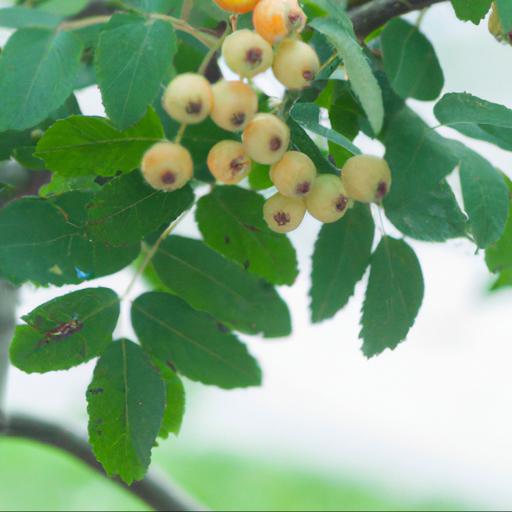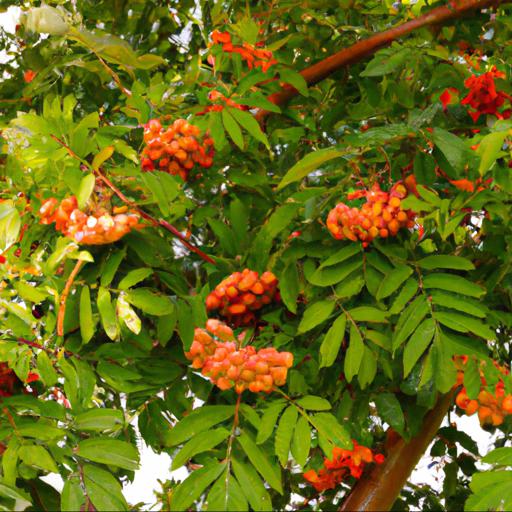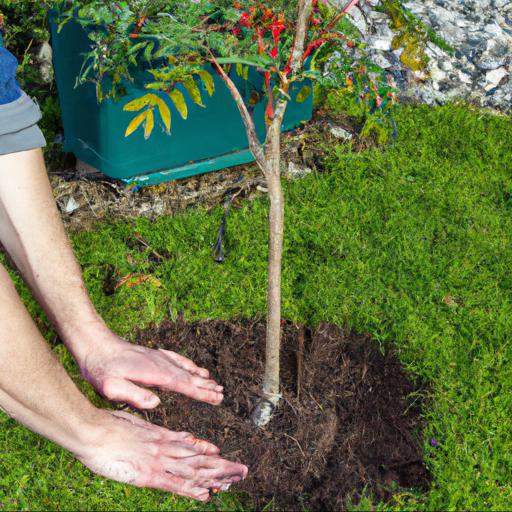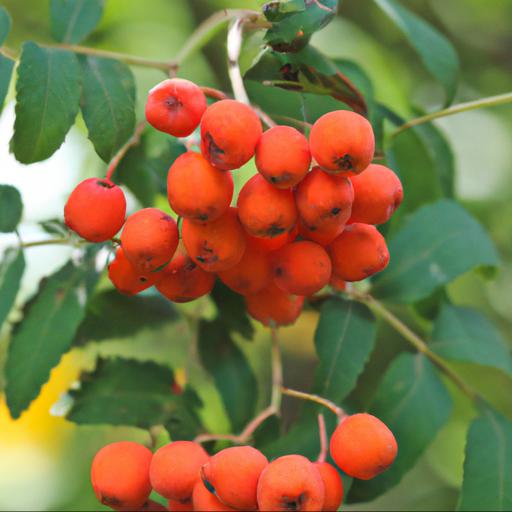Sorbus aria, commonly known as the whitebeam tree, is a species of flowering tree native to Europe and western Asia. It is a deciduous tree that can grow up to 30 metres in height and is known for its white flowers and bright red berries.
The whitebeam tree is an important species for wildlife, providing food and shelter for birds, butterflies and other insects. It is also popular for its ornamental value, with its attractive foliage and bark making it a popular choice for gardens and parks. The whitebeam tree is also used in traditional medicine and has a long history of being used for its healing properties.
This article will explore the many benefits of Sorbus aria and its uses in modern society.
Characteristics of sorbus aria

When it comes to garden plants, Sorbus aria, also known as Whitethorn, is a fantastic choice. With its white, star-like flowers and red fruits, it isn’t difficult to understand why this species is a popular choice.
A native to the UK, this deciduous tree can reach heights of up to 12 metres and spreads out to around 7 metres. Its attractive foliage ranges from a deep green hue to yellow, and its white bark and young stems are delicately speckled with grey. Not only is this species aesthetically pleasing, but it is also relatively low-maintenance.
As it is only mildly affected by pests and diseases, in most cases, very little ongoing care is needed. There is a wide variety of soil types that Sorbus aria can tolerate, and it can grow in both sunny and shady positions.
What’s more, it can be grown in a variety of settings, from small gardens to parks and woodlands. Sorbus aria holds a plethora of benefits for the environment, making it an excellent addition to any garden. This species provides a shelter to a range of birds, animals and insects, provides an abundance of food for wildlife, and also helps to protect the soil from wind and rain damage.
Additionally, its white flowers work to enhance the look of any garden, while also providing delightful scents in the form of sweet smelling blossom. Overall, Sorbus aria is a truly outstanding garden plant that provides beauty, wildlife benefits, and low-maintenance care.
With its statuesque growth and impressive blooms, it is easy to understand why this species is so popular across the UK.
Benefits of growing sorbus aria

As a UK garden expert, I can tell you the many benefits of growing the Sorbus aria, commonly known as the whitebeam, in your garden. This beautiful flowering tree is easy to care for and has a number of beneficial traits that make it an ideal landscaping choice. Firstly, the Sorbus aria can provide a delightful range of visual beauty to your garden.
With its white, fluffy blooms and attractive dark foliage, it can add a wealth of color to any landscape design or garden setting. In the Autumn months, it also produces clusters of red berries which provide wonderful bursts of color to the garden.
Second, the Sorbus aria can act as a natural home for wildlife, providing clumps of berries for birds and mammals to enjoy. It also offers plenty of nesting opportunities for birds and butterflies, making it a great choice for those wanting to help protect local wildlife. Finally, it’s important to remember that the Sorbus aria can last for many years, as it grows slowly and has a deep, strengthened root system that is difficult to remove or damage.
This increases the likelihood that it will be a longterm feature in your garden, so you can be assured of enjoying its beauty for many years to come.
How to plant and care for sorbus aria

When it comes to planting and caring for a Sorbus Aria, UK gardeners have a lot to love! This fast-growing small tree has beautiful white flowers in spring, followed by lush foliage and a bounty of edible red-orange berries in autumn.
With minimal inputs, it can thrive in most UK gardens, making it an ideal addition to any landscape. To give Sorbus Aria the best chance of success, the planting hole should be at least twice as wide as the root ball and filled with a rich soil with the same ratio of soil, peat moss, and compost. Planting is best done in late spring or early summer and should be done in a location that is away from any competing roots and in full or partial sun.
After planting, give the tree generously. Water the soil around the tree twice a week during the growing season and provide organic mulch to retain moisture in the soil and reduce weeds. Pruning is also essential for controlling the height of the tree and maintaining a desired shape.
Pruning should be done in late winter or early spring just before the new growth emerges. For overall health, feed Sorbus Aria with a slow-release fertilizer at the start of each growing season and use an organic pesticide if needed.
When properly planted and cared for, Sorbus Aria can become the pride and joy of any UK garden. It is a hardy tree that adds beauty and a bounty of edible fruits to the landscape and with a few simple inputs, it will thrive for years to come.
Common problems with sorbus aria and how to solve them
As a UK garden expert, I can tell you that Sorbus aria, also known as Whitebeam, is a type of deciduous tree that can grow to a formidable height and is commonly found in gardens in the UK. The tree, with its distinctive white bark and flowers, is renowned for its beauty and is ideal for providing a striking feature in smaller gardens.
However, there are some common problems associated with Sorbus aria that need to be addressed in order to keep the tree healthy and vibrant. Firstly, the Whitebeam is prone to infestations of aphids, a type of insect that feed on foliage and sap, causing the foliage to curl and the leaves to become discoloured. Fortunately, treating an aphid infestation is a simple solution that can be done through the use of an insecticidal soap solution applied directly to the affected area.
This should be done on a regular basis in order to ensure that populations remain manageable. A second problem that can affect Sorbus aria is its susceptibility to fungal leaf spot.
This is caused by an infection of fungal spores that can cause the leaves to discolour and become misshapen. Problematic spots should be pruned off and the area should be treated with a fungicide to help prevent the spread of the infection. It is also important to ensure that the tree has adequate airflow and soil drainage in order to reduce the chances of reinfection.
Finally, Sorbus aria is prone to silver leaf disease, which affects the branches of the tree and causing them to drop off prematurely. It is caused by an infection of the tree’s sap and can cause the bark to become discoloured, although it does not necessarily pose a danger to the tree’s health.
This infection can be treated with an arborvitae oil solution applied directly to the affected branches. In conclusion, Common problems with Sorbus aria can be easily prevented and treated with a combination of regular maintenance and timely intervention. Making sure the tree has the correct environment and adequate care can go a long way to ensuring that it thrives and remains beautiful.
Our video recommendation
Conclusion
Sorbus aria, commonly known as the Whitebeam, is a species of deciduous tree native to Europe, North Africa and parts of Asia. Growing up to 15m in height, it has a rounded crown of white-grey bark and clusters of white flowers in spring, followed by small red berries in autumn. Its leaves are a glossy green on top and a grey-white underneath, giving the tree its name.
Its timber is strong and durable, making it a popular choice for furniture and construction. Sorbus aria is a valuable species for wildlife, providing food and shelter for birds and other animals.
FAQ
What is the scientific name of the Sorbus aria tree?
The scientific name of the Sorbus aria tree is Sorbus aria.
What type of climate is best suited for the Sorbus aria tree?
The Sorbus aria tree is best suited for a temperate climate with cool summers and mild winters.
What are the common uses of the Sorbus aria tree?
The Sorbus aria tree is commonly used as an ornamental tree in parks and gardens. It is also used for its edible fruits, which can be used to make jams, jellies, and juices. The tree is also valued for its timber, which is used to make furniture and other items.
What are the characteristics of the Sorbus aria tree?
The Sorbus aria tree is a deciduous tree that is native to Europe and western Asia. It typically grows to a height of 20–25 m and has a broad, spreading crown. Its bark is greyish-brown and smooth, and its leaves are alternate, ovate-lanceolate, and serrated. The flowers are white, and the fruits are small, round, red berries. The tree is tolerant of a wide range of soils and climates and is often planted as an ornamental.
How long does it take for the Sorbus aria tree to reach maturity?
It typically takes between 10 and 15 years for a Sorbus aria tree to reach maturity.
What are the benefits of planting a Sorbus aria tree?
The benefits of planting a Sorbus aria tree include providing shade, providing food for wildlife, improving air quality, and providing a habitat for birds and other animals. Additionally, the tree is drought-tolerant and can thrive in a variety of soil types.

